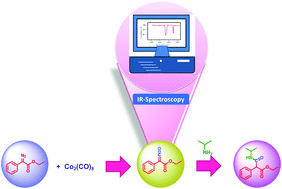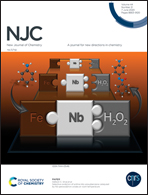Infrared spectroscopic detection of ketene formation from carbene and CO sources: an amide synthesis†
Abstract
The synthesis and transformation of ketene into a desired organic molecule is one of the methodologies widely used in synthetic organic chemistry; however, there are only a few reports available for the detection of ketenes (not free ketene but ketene and transition metal complexes) using expensive techniques. Furthermore, there are no reports on the detection of ketene directly. In this regard, we have developed a methodology to make amides via ketene formation using diazo compounds, [Co2(CO)8] as a carbonyl source, and suitable amines, and then detected the ketene formation with the help of IR spectroscopy. The non-gaseous carbonyl source, [Co2(CO)8], mediated the carbonylation of ethyl 2-diazo-2-phenylacetate and produced ketene as a key intermediate. The transformation of ketene to amide was achieved by the nucleophilic addition of amine. We also made an effort to detect the formation of a ketene intermediate from the reaction between ethyl 2-diazo-2-phenylacetate and [Co2(CO)8] in the absence of a nucleophile. The IR spectroscopy revealed the formation of ketene, followed by the transformation of ketene to an amide by the further addition of amine. The progress of the reaction was monitored over time using IR spectroscopy. Furthermore, all the newly synthesized amides were fully characterized using standard spectroscopic and analytical techniques.



 Please wait while we load your content...
Please wait while we load your content...